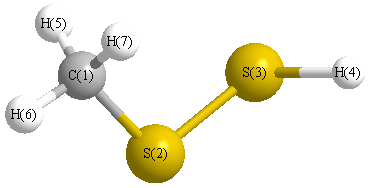Vibrational Frequencies calculated at HF/cc-pVTZ
| Mode Number |
Symmetry |
Frequency
(cm-1) |
Scaled Frequency
(cm-1) |
IR Intensities
(km mol-1) |
Raman Act
(Å4/u) |
Dep P |
Dep U |
|---|
| 1 |
A |
3279 |
2985 |
10.93 |
56.43 |
0.75 |
0.86 |
| 2 |
A |
3261 |
2967 |
9.64 |
82.39 |
0.75 |
0.86 |
| 3 |
A |
3180 |
2894 |
26.44 |
158.49 |
0.02 |
0.04 |
| 4 |
A |
2822 |
2568 |
3.87 |
150.38 |
0.27 |
0.42 |
| 5 |
A |
1599 |
1456 |
7.48 |
6.39 |
0.73 |
0.85 |
| 6 |
A |
1580 |
1438 |
7.76 |
7.80 |
0.75 |
0.86 |
| 7 |
A |
1476 |
1344 |
7.48 |
0.19 |
0.19 |
0.32 |
| 8 |
A |
1066 |
970 |
6.67 |
2.25 |
0.24 |
0.39 |
| 9 |
A |
1058 |
963 |
1.26 |
1.41 |
0.74 |
0.85 |
| 10 |
A |
971 |
884 |
4.65 |
8.64 |
0.65 |
0.79 |
| 11 |
A |
758 |
690 |
1.38 |
18.73 |
0.31 |
0.48 |
| 12 |
A |
555 |
505 |
0.76 |
22.08 |
0.21 |
0.34 |
| 13 |
A |
331 |
301 |
16.69 |
5.64 |
0.75 |
0.86 |
| 14 |
A |
261 |
237 |
0.14 |
4.42 |
0.59 |
0.74 |
| 15 |
A |
187 |
170 |
0.39 |
0.03 |
0.66 |
0.80 |
Unscaled Zero Point Vibrational Energy (zpe) 11191.7 cm
-1
Scaled (by 0.9101) Zero Point Vibrational Energy (zpe) 10185.6 cm
-1
See section
III.C.1 List or set vibrational scaling factors
to change the scale factors used here.
See section
III.C.2
Calculate a vibrational scaling factor for a given set of molecules
to determine the least squares best scaling factor.
Charges, Dipole, Quadrupole and Polarizability
Charges from optimized geometry at HF/cc-pVTZ
Charges (e)
| Number |
Element |
Mulliken |
CHELPG |
AIM |
ESP |
| 1 |
C |
-0.232 |
|
|
|
| 2 |
S |
-0.069 |
|
|
|
| 3 |
S |
-0.140 |
|
|
|
| 4 |
H |
0.110 |
|
|
|
| 5 |
H |
0.117 |
|
|
|
| 6 |
H |
0.105 |
|
|
|
| 7 |
H |
0.107 |
|
|
|
Electric dipole moments
Electric dipole components in Debye
(What's a Debye? See section
VII.A.3)
| |
x |
y |
z |
Total |
| |
-1.115 |
1.319 |
0.867 |
1.932 |
| CHELPG |
|
|
|
|
| AIM |
|
|
|
|
| ESP |
|
|
|
|
Electric Quadrupole moment
Quadrupole components in D Å
| Primitive |
|---|
| | x | y | z |
|---|
| x |
-31.006 |
-0.314 |
1.791 |
| y |
-0.314 |
-35.324 |
0.673 |
| z |
1.791 |
0.673 |
-33.354 |
|
| Traceless |
|---|
| | x | y | z |
|---|
| x |
3.333 |
-0.314 |
1.791 |
| y |
-0.314 |
-3.144 |
0.673 |
| z |
1.791 |
0.673 |
-0.189 |
|
| Polar |
|---|
| 3z2-r2 | -0.378 |
|---|
| x2-y2 | 4.318 |
|---|
| xy | -0.314 |
|---|
| xz | 1.791 |
|---|
| yz | 0.673 |
|---|
|
Polarizabilities
Components of the polarizability tensor.
Units are
Å
3 (Angstrom cubed)
Change units.
| |
x |
y |
z |
| x |
9.467 |
0.285 |
0.151 |
| y |
0.285 |
6.429 |
0.084 |
| z |
0.151 |
0.084 |
5.566 |
<r2> (average value of r
2) Å
2
| <r2> |
102.078 |
| (<r2>)1/2 |
10.103 |
